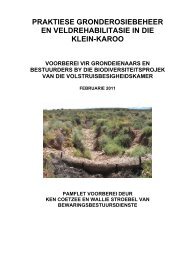REHABILITATION: REHABILITATION: A QUICK GUIDE A ... - saobc
REHABILITATION: REHABILITATION: A QUICK GUIDE A ... - saobc
REHABILITATION: REHABILITATION: A QUICK GUIDE A ... - saobc
Create successful ePaper yourself
Turn your PDF publications into a flip-book with our unique Google optimized e-Paper software.
2.7 PLANT ESTABLISHMENT<br />
The establishment of an effective soil protecting vegetation cover should be seen as<br />
the ultimate objective for all of the rehabilitation project sites of the study area.<br />
Each of the soil erosion/habitat rehabilitation methods involves the establishment of<br />
locally indigenous plants, either from seed or by planting rooted cuttings.<br />
2.7.1 SPECIES<br />
The establishment of plants must be carefully considered in terms of the varied<br />
requirements and tolerances of the range of local plant species. The study area<br />
typically contains alkaline (lime patch) soils and also saline soils - the soil is<br />
generally not very deep and often underlain by hard stone layers (dorbank)<br />
2.7.2 PLANT ESTABLISHMENT<br />
All plant establishment should be accompanied by some form of microhabitat<br />
treatment to be effective. Conditions otherwise will simply be too environmentally<br />
harsh (high temperatures, exposure, arid) for successful seedling establishment.<br />
The forms of microhabitat treatment have already been described and include:<br />
Creating moisture capturing hollows, mulching with plant material, surface covering<br />
with jute geotextile and overmulching with chip mulch.<br />
All plant establishment within the study sites must thus be within, or accompanied<br />
by one or more if these treatments.<br />
2.8 ALIEN PLANTS<br />
All invasive alien plants should be removed from the “camps” during the<br />
rehabilitation process. Alien plants are nowhere numerous and generally consist of<br />
a small number of isolated plants. The species observed were Opuntia ficus indica<br />
(turksvy), Agave americana (garingboom) and Atriplex nummularia (ouman<br />
soutbos).<br />
The oumansoutbos can be cut off at ground level and used for chip mulching on the<br />
treatments. The turksvy and garingboom plants should be dug out and removed to<br />
a site where they can dry out and die.<br />
2.9 EXCLUSION FROM GRAZING<br />
The application of the suggested rehabilitation methods must be followed by a<br />
substantial period of exclusion from grazing by ostriches (and other livestock) if the<br />
rehabilitation is to be a success. Ideally, the rehabilitation camps should be<br />
indefinitely rested from ostrich utilization but this may not be practical.<br />
The rehabilitation trials are to serve as demonstration sites where visiting<br />
landowners can view the varying success of the different treatments over an<br />
experimental period. These camps therefore need to be excluded from use for at<br />
least 3 to 5 years so that the effects of at least one reasonably good rain season<br />
can develop and be observed. Rehabilitation progress in the low rainfall and harsh<br />
26



